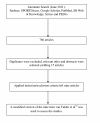The effectiveness of neuromuscular warm-up strategies, that require no additional equipment, for preventing lower limb injuries during sports participation: a systematic review - PubMed (original) (raw)
Review
The effectiveness of neuromuscular warm-up strategies, that require no additional equipment, for preventing lower limb injuries during sports participation: a systematic review
Katherine Herman et al. BMC Med. 2012.
Abstract
Background: Lower limb injuries in sport are increasingly prevalent and responsible for large economic as well as personal burdens. In this review we seek to determine which easily implemented functional neuromuscular warm-up strategies are effective in preventing lower limb injuries during sports participation and in which sporting groups they are effective.
Methods: Seven electronic databases were searched from inception to January 2012 for studies investigating neuromuscular warm-up strategies and injury prevention. The quality of each included study was evaluated using a modified version of the van Tulder scale. Data were extracted from each study and used to calculate the risk of injury following application of each evaluated strategy.
Results: Nine studies were identified including six randomized controlled trials (RCT) and three controlled clinical trials (CCT). Heterogeneity in study design and warm-up strategies prevented pooling of results. Two studies investigated male and female participants, while the remaining seven investigated women only. Risk Ratio (RR) statistics indicated 'The 11+' prevention strategy significantly reduces overall (RR 0.67, confidence interval (CI) 0.54 to 0.84) and overuse (RR 0.45, CI 0.28 to 0.71) lower limb injuries as well as knee (RR 0.48, CI 0.32 to 0.72) injuries among young amateur female footballers. The 'Knee Injury Prevention Program' (KIPP) significantly reduced the risk of noncontact lower limb (RR 0.5, CI 0.33 to 0.76) and overuse (RR 0.44, CI 0.22 to 0.86) injuries in young amateur female football and basketball players. The 'Prevent Injury and Enhance Performance' (PEP) strategy reduces the incidence of anterior cruciate ligament (ACL) injuries (RR 0.18, CI 0.08 to 0.42). The 'HarmoKnee' programme reduces the risk of knee injuries (RR 0.22, CI 0.06 to 0.76) in teenage female footballers. The 'Anterior Knee Pain Prevention Training Programme' (AKP PTP) significantly reduces the incidence of anterior knee pain (RR 0.27, CI 0.14 to 0.54) in military recruits.
Conclusions: Effective implementation of practical neuromuscular warm-up strategies can reduce lower extremity injury incidence in young, amateur, female athletes and male and female military recruits. This is typically a warm-up strategy that includes stretching, strengthening, balance exercises, sports-specific agility drills and landing techniques applied consistently for longer than three consecutive months. In order to optimize these strategies, the mechanisms for their effectiveness require further evaluation.
Figures
Figure 1
Flowchart to demonstrate the literature search.
Figure 2
Forest plot graph demonstrating risk ratios for the effectiveness of neuromuscular warm-up strategies in preventing undefined lower limb injuries.
Figure 3
Forest plot graph demonstrating risk ratios for the effectiveness of neuromuscular warm-up strategies in preventing hip and thigh injuries.
Figure 4
Forest plot graph demonstrating risk ratios for the effectiveness of neuromuscular warm-up strategies in preventing knee injuries.
Figure 5
Forest plot graph demonstrating risk ratios for the effectiveness of neuromuscular warm-up strategies in preventing lower leg and knee injuries.
Similar articles
- Neuromuscular training to prevent knee injuries in adolescent female soccer players.
Wingfield K. Wingfield K. Clin J Sport Med. 2013 Sep;23(5):407-8. doi: 10.1097/01.jsm.0000433153.51313.6b. Clin J Sport Med. 2013. PMID: 23989384 - A multicomponent neuromuscular warm-up program reduces lower-extremity injuries in trained basketball players: a cluster randomized controlled trial.
Stojanović E, Terrence Scanlan A, Radovanović D, Jakovljević V, Faude O. Stojanović E, et al. Phys Sportsmed. 2023 Oct;51(5):463-471. doi: 10.1080/00913847.2022.2133978. Epub 2022 Oct 12. Phys Sportsmed. 2023. PMID: 36208619 Clinical Trial. - Soccer-specific warm-up and lower extremity injury rates in collegiate male soccer players.
Grooms DR, Palmer T, Onate JA, Myer GD, Grindstaff T. Grooms DR, et al. J Athl Train. 2013 Nov-Dec;48(6):782-9. doi: 10.4085/1062-6050-48.4.08. Epub 2013 Jul 12. J Athl Train. 2013. PMID: 23848519 Free PMC article. - Rationale and implementation of anterior cruciate ligament injury prevention warm-up programs in female athletes.
Bien DP. Bien DP. J Strength Cond Res. 2011 Jan;25(1):271-85. doi: 10.1519/JSC.0b013e3181fb4a5a. J Strength Cond Res. 2011. PMID: 21116195 Review. - Prevention of Knee and Anterior Cruciate Ligament Injuries Through the Use of Neuromuscular and Proprioceptive Training: An Evidence-Based Review.
Dargo L, Robinson KJ, Games KE. Dargo L, et al. J Athl Train. 2017 Dec;52(12):1171-1172. doi: 10.4085/1062-6050-52.12.21. Epub 2017 Nov 27. J Athl Train. 2017. PMID: 29172648 Free PMC article. Review.
Cited by
- Cardiovascular Response and Locomotor Demands of Elite Basketball Referees During International Tournament: A Within- and Between-Referee Analysis.
Pojskić H, Užičanin E, Suárez-Iglesias D, Vaquera A. Pojskić H, et al. Sensors (Basel). 2024 Oct 28;24(21):6900. doi: 10.3390/s24216900. Sensors (Basel). 2024. PMID: 39517797 Free PMC article. - Predictors of Anterior Cruciate Ligament Tears in Adolescents and Young Adults.
Etzel CM, Meghani O, Owens BD, Kocher MS, Field AE. Etzel CM, et al. Orthop J Sports Med. 2024 Sep 19;12(9):23259671241272699. doi: 10.1177/23259671241272699. eCollection 2024 Sep. Orthop J Sports Med. 2024. PMID: 39345931 Free PMC article. - The influence of static and dynamic warm-up on knee temperature: infrared thermography insights before and after a change of direction exercise.
Trovato B, Sortino M, Petrigna L, Roggio F, Musumeci G. Trovato B, et al. Front Physiol. 2024 Aug 1;15:1393804. doi: 10.3389/fphys.2024.1393804. eCollection 2024. Front Physiol. 2024. PMID: 39148745 Free PMC article. - ACL Injury Prevention Education Improves Implementation of Neuromuscular Training Among High School Sports Coaches: A Cross-Sectional Survey Study.
Janosky JJ, Russomano J, Duscha C, Henderson A, Archer A, Kinderknecht JJ, Marx RG. Janosky JJ, et al. HSS J. 2024 Aug;20(3):327-332. doi: 10.1177/15563316241236194. Epub 2024 Mar 13. HSS J. 2024. PMID: 39108451 - Before hitting the slopes: athlete and staff perspectives on warm-up and activation in high-performance snowsports.
Beck L, Bekker S, Verhagen E, Bolling C, Spörri J. Beck L, et al. BMJ Open Sport Exerc Med. 2024 Jan 8;10(1):e001643. doi: 10.1136/bmjsem-2023-001643. eCollection 2024. BMJ Open Sport Exerc Med. 2024. PMID: 38268527 Free PMC article.
References
Publication types
MeSH terms
LinkOut - more resources
Full Text Sources
Medical
Miscellaneous




